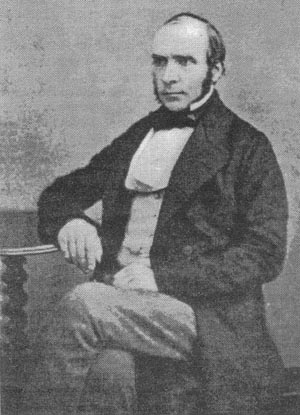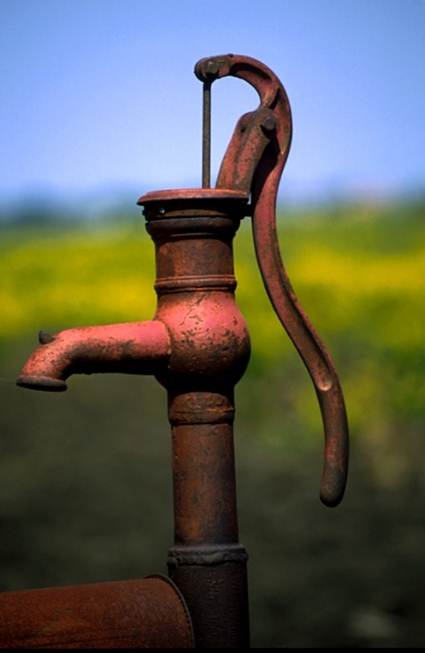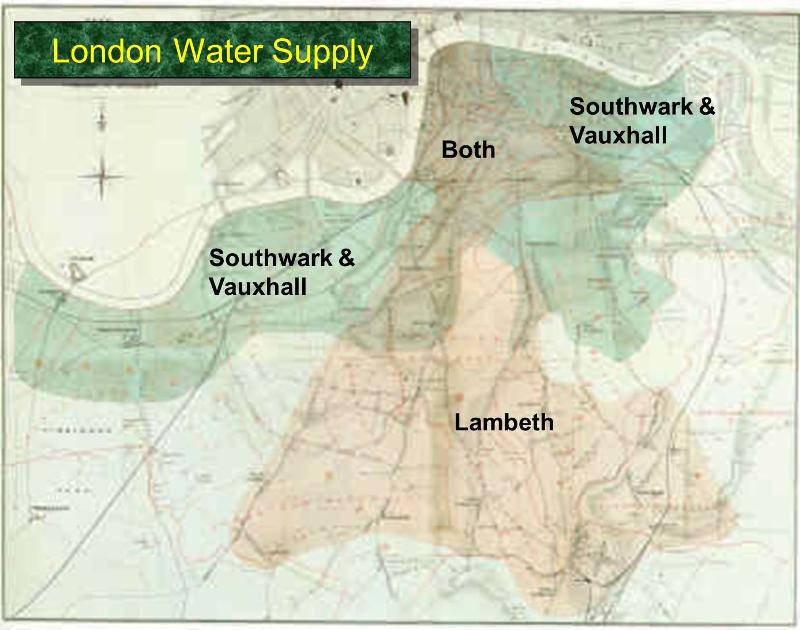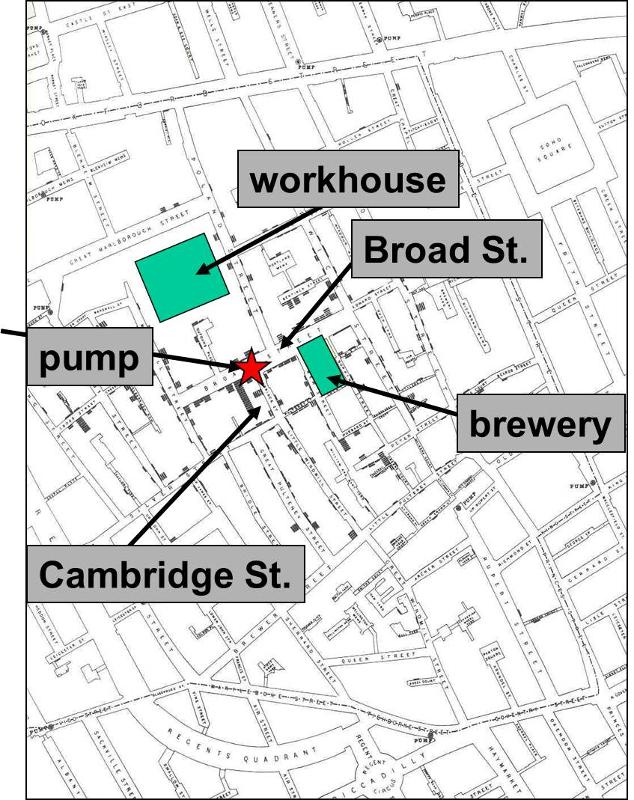John Snow - The Father of Epidemiology
Cholera is an infectious disease that became a major threat to health during the 1800s. The story has been elegantly told in The Ghost Map by Steven Johnson, who describes the conditions in London in the 1800s situation in the brief video below.
Cholera continues to be a problem throughout the world today (see Cholera in Haiti). The next video describes the cholera epidemic in Haiti in 2010.
In the 1800s there were large epidemics of cholera in Europe and America that killed thousands of people. John Snow (shown below) was a physician in London who spent several decades studying cholera in a systematic way. He is most often credited with solving an outbreak of cholera that occurred in London in 1854 (the outbreak is described below), but his studies of cholera were much more extensive than that. The first cholera epidemic in London struck in 1831, when Snow was still an apprentice. Another large epidemic occurred in 1848 and lasted through 1849.

The prevailing opinion was that cholera was spread either by miasmas or by person-to-person contact, Snow began examining the victims and found that their initial symptoms were always related to the gastrointestinal tract. Snow reasoned that, if cholera was spread by bad air, it should cause pulmonary symptoms, but since the symptoms were gastrointestinal, perhaps it was transmitted by water or food consumption. In fact, cholera is caused by the bacterium, Vibrio cholera, which is transmitted by the fecal-oral route, that is by ingestion of water or food that is contaminated with sewage.
In August 1849 Snow published a paper entitled "On the Mode of Communication of Cholera" in which he presented his theory that the disease was acquired by ingestion of contaminated water, but his theory did not get much traction with the medical establishment. The epidemic ended in 1849, but Snow continued to collect data on the pattern of of disease and began finding evidence that linked cholera to specific sources of water.
Many Londoners received their water from hand pump wells (below) that were located throughout the city.

However, increasing numbers of businesses and homes had water piped from the Thames River by private companies. Snow learned from municipal records that two private companies supplied piped in water to the areas that were primarily affected by cholera. Some consumers were supplied by the Lambeth Company, while others were supplied by Southwark & Vauxhall. The map of London below shows the areas of London supplied by these two water companies.

Southwark & Vauxhall pumped water from a more downstream location that was clearly contaminated, and the rates of cholera were clearly higher in their customers compared to those supplied by the Lambeth Company. Nevertheless, many were unconvinced by his findings, since Snow had not actually demonstrated that the water contained something that could cause cholera.
| Water Company | # of Houses Served | # of Cholera Deaths | Death Rate per 10,000 Houses |
|---|---|---|---|
| Southwark & Vauxhal | 40,046 | 1,263 | 315 |
| Lambeth | 28,107 | 98 | 37 |
| The rest of London | 256,423 | 1,422 | 59 |
In late August of 1853, cholera broke out in the Broad Street area, and the residents panicked and many began to flee. A hand pump was located right on Broad Street, and Snow was immediately suspicious. Water samples did not reveal gross contamination, but Snow persisted and began to collect detailed information on where the victims had gotten their drinking water. He obtained the names and the addresses of the first 83 victims who had died by the end of the first week. He went to their homes and learned from relatives that the vast majority of them had obtained their water from the Broad St. pump.
On Sept. 6 Snow appeared at the meeting of the local Board of Guardians and presented his evidence that the pump was the source of the outbreak. He argued that the pump handle should be removed in order to prevent further contamination. The board was not convinced, but agreed to remove the pump handle as a precaution. The epidemic quickly subsided.
The investigation continued. Ultimately, Snow was able to track down 197 victims, the vast majority of whom lived within walking distance of the pump. It was also noted that there was an extremely low incidence of cholera at a nearby work house and also at the Lion Brewery, and both of these businesses had their own water supply. The workers at another large business used water from the Broad St. pump, and their workers had a substantial incidence of cholera.
The map below shows the location of the pump, and the home or business location of the victims is shown by stacks of small dark marks that are clearly clustered around the pump. This type of map, which marks the location of disease cases, is now referred to as a "spot map."

An initial examination of the well failed to show any problems, casting doubt on Snow's conclusions, and the pump was reopened without incident. However, some months later an associate of Snow's stumbled upon the records of an infant who had died of diarrhea at the very beginning of the outbreak. The timing of her death indicated that she had been the first cholera case. Upon questioning, the mother said that she had emptied a pail of the infant's diarrhea into a cesspool in front of their house immediately adjacent to the water pump. The cesspool and the pump well were than excavated, revealing that the cesspool, which was within three feet of the well, was leaking, and the wall of the well was decayed, allowing the contamination from the cesspool to seep in. In retrospect, it appeared that once the child died, there was no further contamination of the well, and the epidemic ended.
This graph shows the number of cholera deaths over time. There is an abrupt increase in cholera deaths at the very end of August. Deaths peak on September 2, when there were about 130 deaths, and the cholera death rate gradually declines to near zero over the next three weeks.

With knowledge of the incubation period for the disease, the shape of an epidemic curve can sometimes provide clues regarding the source of the epidemic. Cholera has an incubation period of only 1-3 days, and this graph indicates that new cases occurred over a period of about 10 days. This suggests a "continuous source" epidemic of cholera exposure because new cases continue to occur for more than one incubation period, suggesting an ongoing source of contamination.
In retrospect, Snow made several important contributions to the development of epidemiologic thinking:
- He proposed a new hypothesis for how cholera was transmitted.
- He tested this hypothesis systematically by making comparisons between groups of people.
- He provided evidence for an association between drinking from the Broad St. well and getting cholera.
- He argued for an intervention which prevented additional cases (removal of the pump handle).
